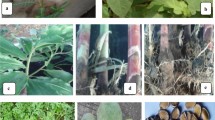Abstract
Eleven ash samples obtained from nine tropical plants were screened in vitro for their potential to reduce the mycelial growth of the seedborne pathogens Helminthosporium sativum, Curvularia lunata and Fusarium graminearum. All ash samples inhibited the mycelial growth of these pathogens. Delonix regia wood ash induced up to 77.8, 80.7 and 88.8% reduction in the mycelial growth of H. sativum, C. lunata and F. graminearum, respectively. Ricinus communis leaf ash induced reductions above 70.0% in the mycelial growth of C. lunata while Eichornia crassipes ash induced 88.3% reduction in the mycelial growth of F. graminearum. The fungitoxicity of ash samples from inflorescences of Elaeis guineensis was weak. This study shows the prospect of plant ash in the control of seedborne pathogens.
Similar content being viewed by others
References
Amadioha AC (2004) Control of black rot of potato caused by Rhizoctonia bataticola using some plant leaf extracts. Archives of Phytopathology and Plant Protection 37, 111–117. doi: 10.1080/0323540042000202067
Awuah RT (1989) Fungitoxic effects of extracts of someWest African plants. The Annals of Applied Biology 115, 451–454.
Biswas S, Das NK, Qadri SMH, Saratchandra B (1995) Evaluation of different plant extracts against major mulberry diseases. Indian Phytopathology 48, 342–346.
Ekpo EJA, Banjoko KM (1994) Efficacy of Fernasan D and wood ash in the control of seed-borne fungi, pre-emergence mortality and seedling blight of maize. Discovery and Innovation 6, 84–88.
Enikuomehin OA, Ikotun T, Ekpo EJA (1998) Evaluation of ash from tropical plants of Nigeria for the control of Sclerotium rolfsii Sacc. on wheat (Triticum aestivum L.). Mycopathologia 142, 81–87. doi: 10.1023/A:1006926817580
Eze CS, Maduewesi JNC (1990) Comparative efficacy of benlate, lime and plant ash treatments in controlling freshweight loss, sprouting and rotting of cocoyam (Colocassia esculenta L.) in storage. Nigerian Journal of Plant Protection 13, 81–89.
Nnodu EC, Nwankiti JO (1986) Post-harvest deterioration of yam tubers. Fitopatologia Brasileira 11, 864–871.
Osai EO (1992) Microbial rot of yam (Dioscorea spp.) minisetts and Cassava (Manihot esculenta Crantz) ministems. PhD Thesis, University of Ibadan, Nigeria. 271 pp.
Raja J, Kurucheve V (1997) Fungitoxicity of crude animal products against Rhizoctonia solani. Plant Disease Research 11, 11–14.
Zarafi AB, Emechebe AM (2006) Effect of intra row spacing on the incidence and severity of pearl millet downy mildew and grain yield. Archives of Phytopathology and Plant Protection 39, 9–14. doi: 10.1080/03235400500094746
Author information
Authors and Affiliations
Corresponding author
Rights and permissions
About this article
Cite this article
Enikuomehin, O.A., Kehinde, I.A. In vitro screening of some tropical ash samples against seedborne pathogens of wheat (Triticum aestivum L.). Australasian Plant Pathology 36, 587–590 (2007). https://doi.org/10.1071/AP07066
Received:
Accepted:
Issue Date:
DOI: https://doi.org/10.1071/AP07066




